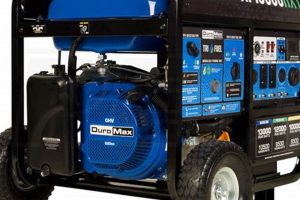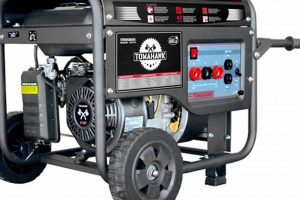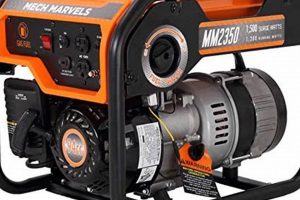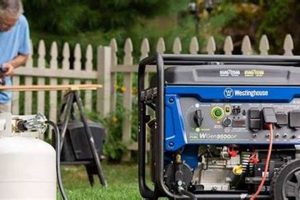Compact, fuel-powered electricity sources offer a convenient solution for temporary power needs. These devices convert the chemical energy of gasoline into electrical energy, often featuring a single-cylinder internal combustion engine coupled to an alternator. Common applications include powering tools at remote job sites, providing backup electricity during outages, and facilitating recreational activities like camping.
The value of these compact power sources lies in their portability and independence from the electrical grid. This independence proves crucial during emergencies, natural disasters, or in locations lacking grid access. Their relatively small size and weight allow easy transportation and storage, making them indispensable for various professional and leisure activities. Historically, the need for mobile power generation has driven innovation in engine and alternator technology, leading to increasingly efficient and quieter units.
This discussion will delve into the various types of compact gasoline-powered generators, exploring their power output capacities, fuel efficiency, noise levels, and maintenance requirements. Furthermore, the content will cover critical safety considerations, operational best practices, and environmental impact.
Operational and Safety Guidance for Portable Generators
Proper operation and adherence to safety guidelines are crucial for maximizing the effectiveness and lifespan of portable generators while minimizing potential hazards.
Tip 1: Calculate Power Needs: Accurately assess the wattage requirements of devices intended for connection. Overloading can damage both the generator and the connected equipment.
Tip 2: Proper Ventilation is Essential: Operate units outdoors in well-ventilated areas. Exhaust fumes contain carbon monoxide, a colorless, odorless, and lethal gas.
Tip 3: Ground Fault Circuit Interrupters (GFCIs): Utilize GFCI-protected outlets to minimize the risk of electrical shock, especially in damp or wet conditions.
Tip 4: Fuel Handling Precautions: Refuel only when the unit is cool and switched off. Store fuel in approved containers away from ignition sources.
Tip 5: Regular Maintenance: Adhere to the manufacturer’s recommended maintenance schedule, including oil changes, air filter cleaning, and spark plug replacement.
Tip 6: Dry Storage: Protect the unit from moisture when not in use. Store in a clean, dry location to prevent corrosion and damage.
Tip 7: Safe Connections: Ensure all connections are secure and free of damage. Inspect power cords for wear and tear before each use.
Adherence to these guidelines promotes safe and efficient operation, extending the lifespan of the generator and ensuring user safety.
By understanding these crucial operating and safety principles, users can effectively leverage the benefits of portable power generation while mitigating potential risks. This knowledge contributes to a more reliable and secure power experience.
1. Portability
Portability represents a defining characteristic of these compact power sources, directly influencing their usability and applicability. The compact form factor, often incorporating integrated handles or wheel kits, facilitates easy transport across varied terrains. This mobility proves essential in scenarios ranging from remote construction sites and outdoor events to emergency power provision during outages. Consider a contractor needing to power tools on a job site without readily available electricity; the portability of a compact generator becomes crucial for project completion. Similarly, during a power outage, a portable unit facilitates essential appliance operation, enhancing safety and comfort. The unit’s weight and dimensions directly impact its portability, and manufacturers strive to optimize these factors without compromising power output or runtime.
The portability of these generators expands their utility beyond stationary applications. Tailgating, camping, and other recreational activities benefit significantly from their compact size and ease of transport. Imagine powering a campsite’s lighting and essential appliances this convenience relies heavily on the generator’s portability. Furthermore, disaster relief efforts often depend on these mobile power sources to provide essential services in affected areas. This highlights the practical significance of portability, enabling crucial support in challenging and unpredictable circumstances.
In summary, portability significantly enhances the versatility and practicality of compact generators. This feature broadens their application across diverse sectors, from professional work environments and recreational pursuits to emergency preparedness and disaster relief. While power output and runtime remain critical considerations, portability underscores the core value proposition of these adaptable power solutions, facilitating access to electricity wherever and whenever it is needed.
2. Power Output
Power output, measured in watts, represents a critical specification for portable generators, directly determining the types and number of devices it can power simultaneously. This output dictates the generator’s capacity to handle electrical loads, ranging from small electronic devices to power-hungry appliances. Understanding the power requirements of intended devices is crucial for selecting a generator with adequate capacity. For instance, a generator with a 2000-watt output may suffice for powering essential lights and a small refrigerator during a power outage, while a 5000-watt unit might be necessary for running power tools on a construction site. Insufficient power output can lead to overloading, potentially damaging both the generator and connected devices. Conversely, an excessively high output results in unnecessary fuel consumption and increased operational costs.
The relationship between power output and practical application is further nuanced by the distinction between starting watts and running watts. Starting watts refer to the surge of power required to initially start motor-driven appliances, often significantly higher than the running watts needed for sustained operation. A generator’s starting wattage capacity must accommodate these initial surges to prevent stalling or damage. Consider a circular saw requiring 2000 starting watts and 1500 running watts; a generator with a starting wattage below 2000 watts would be inadequate, even if its running wattage exceeds 1500. This distinction emphasizes the importance of carefully evaluating both starting and running wattage requirements when selecting a generator for specific applications.
Effective power output assessment is fundamental for maximizing generator utility and preventing equipment damage. Matching the generator’s output to the intended load ensures efficient operation and prolongs the generator’s lifespan. Understanding the nuances of starting and running watts further refines this selection process, enabling users to choose the most appropriate generator for their specific power needs, whether for emergency backup, recreational use, or professional applications. This informed approach optimizes resource utilization and ensures reliable power delivery in diverse scenarios.
3. Fuel Efficiency
Fuel efficiency represents a critical operational parameter for small portable gas generators, directly impacting running costs and environmental impact. Efficient fuel consumption reduces operational expenses and minimizes the generator’s carbon footprint. This factor becomes particularly significant during extended operation or in scenarios where refueling is inconvenient or costly.
- Runtime and Fuel Tank Capacity
Runtime, the duration a generator can operate on a single tank of fuel, is directly linked to fuel efficiency. A larger fuel tank combined with efficient fuel consumption translates to extended operation without refueling. This is crucial for applications like prolonged power outages or remote work sites. A generator with a larger tank and higher fuel efficiency provides a more practical and cost-effective solution in such situations. Conversely, a smaller tank and lower efficiency necessitate more frequent refueling, increasing operational costs and potentially interrupting critical tasks.
- Engine Technology and Design
Engine design significantly influences fuel efficiency. Advanced engine technologies, such as overhead valve (OHV) designs, optimize combustion efficiency, extracting more energy from each unit of fuel. This translates to longer runtimes and reduced fuel consumption compared to less efficient engine designs. Furthermore, features like automatic idle control dynamically adjust engine speed based on load, further enhancing fuel efficiency during periods of lower power demand. This reduces unnecessary fuel consumption when the generator is not operating at full capacity.
- Load Management and Power Demand
Operating the generator at its optimal load range maximizes fuel efficiency. Overloading or underloading the generator can negatively impact fuel consumption. Operating within the manufacturer’s recommended load range ensures efficient fuel utilization. Understanding the power demands of connected devices and avoiding unnecessary loads contributes significantly to optimized fuel efficiency. Matching the generator’s output to the specific power needs minimizes waste and reduces operational costs.
- Maintenance and Operating Conditions
Regular maintenance, including clean air filters and spark plugs, contributes to optimal fuel efficiency. A well-maintained engine operates more efficiently, minimizing fuel waste. Similarly, operating the generator in appropriate environmental conditions, such as avoiding extreme temperatures, further enhances fuel efficiency. Proper maintenance and suitable operating conditions ensure that the generator consistently performs at its peak efficiency, maximizing fuel economy and extending the generator’s operational lifespan.
Understanding these facets of fuel efficiency empowers users to make informed decisions, optimizing operational costs and minimizing environmental impact. Selecting a fuel-efficient generator ensures cost-effective and sustainable power generation, aligning with both economic and environmental considerations. This conscious approach contributes to responsible resource utilization and reduces the generator’s overall operational footprint.
4. Noise Levels
Noise levels represent a crucial consideration when evaluating small portable gas generators, directly impacting their suitability for various applications and environments. Excessive noise can disrupt activities, disturb neighbors, and even pose health risks with prolonged exposure. Understanding the factors influencing noise production and available mitigation strategies is essential for responsible generator operation.
- Decibel Levels and Human Perception
Noise output, measured in decibels (dB), quantifies the intensity of sound produced by a generator. The logarithmic decibel scale reflects the human ear’s perception of loudness, with each 10 dB increase representing a perceived doubling of sound intensity. A generator operating at 70 dB, typical for quieter models, is perceived as twice as loud as one operating at 60 dB. Prolonged exposure to levels above 70 dB can contribute to hearing damage, underscoring the importance of noise level consideration, especially for extended operation. Choosing a generator with lower dB ratings minimizes noise pollution and protects hearing health.
- Engine Design and Construction
Engine design and construction significantly influence noise generation. Modern OHV engine designs and advanced muffler systems contribute to lower noise output compared to older, less refined engine technologies. Furthermore, the generator’s housing construction plays a role in noise suppression. Units with robust, well-insulated housings minimize noise leakage, contributing to quieter operation. Manufacturers often employ noise-reducing technologies and materials to minimize operational noise, making them suitable for noise-sensitive environments.
- Operational Factors and Load
Operational factors, including load and engine speed, affect noise output. Higher loads typically result in increased engine speed and consequently higher noise levels. Operating the generator within its optimal load range not only maximizes fuel efficiency but also helps minimize noise production. Avoiding overloading the generator contributes to quieter operation. Additionally, some generators offer “eco-mode” or similar features that adjust engine speed based on load, further reducing noise during periods of lower power demand.
- Mitigation Strategies and Best Practices
Various strategies can mitigate generator noise. Positioning the generator farther from work or living areas reduces noise impact. Utilizing sound-dampening barriers or enclosures further minimizes noise propagation. Proper maintenance, including ensuring a functional muffler, also contributes to quieter operation. These mitigation strategies help create a more comfortable and less disruptive operating environment. Selecting a quieter generator model combined with appropriate noise reduction measures ensures responsible and considerate operation, minimizing disturbance to both users and the surrounding environment.
Careful consideration of noise levels contributes significantly to responsible generator selection and operation. Understanding the factors influencing noise output and implementing appropriate mitigation strategies ensures minimal disruption and promotes a safer, more comfortable environment for users and those nearby. This awareness fosters a more considerate and harmonious integration of portable power generation into various settings, minimizing noise pollution and promoting user well-being.
5. Runtime
Runtime, representing the duration a small portable gas generator can operate continuously on a single fuel tank, constitutes a critical performance metric. This duration directly influences the generator’s practicality and suitability for various applications. Runtime is intrinsically linked to fuel tank capacity and fuel efficiency. A larger fuel tank, combined with efficient fuel consumption, yields extended runtimes, reducing the frequency of refueling. This extended operation proves invaluable during prolonged power outages or in remote locations where refueling access is limited. Consider a scenario where a generator powers essential medical equipment during an extended outage; a longer runtime ensures uninterrupted operation, potentially critical for patient care. Conversely, shorter runtimes necessitate frequent refueling, potentially interrupting essential operations and increasing operational overhead.
The practical significance of runtime extends beyond emergency situations. In recreational contexts, such as camping or tailgating, runtime dictates the duration of available power for amenities and devices. A longer runtime translates to uninterrupted enjoyment, while a shorter runtime might require carrying additional fuel or curtailing usage. Furthermore, professional applications, such as powering tools on construction sites, benefit from extended runtimes, minimizing downtime and maximizing productivity. A contractor can complete tasks efficiently with a generator offering a longer runtime without interruptions for refueling. Therefore, understanding runtime limitations and planning accordingly is essential for maximizing the generator’s utility across diverse applications.
Effective runtime assessment requires considering both fuel tank capacity and the generator’s fuel consumption rate under anticipated load conditions. Manufacturers typically provide runtime estimates at various load levels, enabling users to make informed decisions based on their specific power needs. This understanding empowers users to select a generator that aligns with their operational requirements, ensuring sufficient power for the intended duration. Furthermore, optimizing generator load and utilizing fuel-saving features, such as “eco-mode,” can extend runtime and minimize fuel consumption, enhancing the generator’s overall efficiency and value. This holistic approach ensures reliable and uninterrupted power delivery, maximizing the generator’s utility across a range of practical applications.
6. Maintenance
Regular maintenance is essential for ensuring the reliable and long-lasting performance of a small portable gas generator. Neglecting routine maintenance can lead to decreased performance, reduced lifespan, and potentially hazardous operating conditions. A proactive maintenance approach maximizes the generator’s value and ensures safe and efficient operation.
- Oil Changes
Regular oil changes are fundamental for lubricating engine components, reducing friction, and preventing overheating. Engine oil degrades over time, losing its lubricating properties. Adhering to the manufacturer’s recommended oil change intervals, typically based on operating hours, ensures optimal engine performance and longevity. Failing to change the oil can lead to increased engine wear, reduced efficiency, and potentially catastrophic engine failure. Using the correct oil type and viscosity, as specified in the owner’s manual, is crucial for maintaining proper lubrication and preventing damage.
- Air Filter Maintenance
Clean air filters are crucial for proper engine combustion. A clogged air filter restricts airflow to the engine, reducing combustion efficiency and increasing fuel consumption. Regularly cleaning or replacing the air filter, as recommended by the manufacturer, ensures optimal airflow and maintains engine performance. Operating the generator in dusty or dirty environments necessitates more frequent air filter maintenance. Neglecting air filter maintenance can lead to reduced power output, increased fuel consumption, and potential engine damage.
- Spark Plug Replacement
Spark plugs ignite the fuel-air mixture within the engine cylinder. Over time, spark plugs wear down, affecting ignition efficiency and engine performance. Replacing spark plugs according to the manufacturer’s recommendations ensures reliable ignition and optimal fuel combustion. Worn spark plugs can cause difficulty starting, rough running, and reduced fuel efficiency. Using the correct spark plug type, as specified in the owner’s manual, is essential for proper engine operation.
- Fuel System Maintenance
Maintaining the fuel system is crucial for preventing fuel-related issues that can affect generator performance. This includes regularly inspecting fuel lines for leaks or damage and ensuring the fuel tank is free of debris or contaminants. Using fresh, clean fuel and adding a fuel stabilizer, especially during periods of extended storage, prevents fuel degradation and carburetor clogging. Draining the fuel system before long-term storage further protects against fuel-related problems. Proper fuel system maintenance ensures reliable starting and consistent performance.
These maintenance practices collectively contribute to the long-term reliability and performance of a small portable gas generator. Adhering to a comprehensive maintenance schedule, as outlined in the owner’s manual, maximizes the generator’s lifespan, ensures safe operation, and minimizes potential downtime. This proactive approach represents a crucial investment in the generator’s longevity and operational efficiency, ultimately enhancing its value and utility.
7. Safety Features
Safety features in small portable gas generators are crucial for mitigating potential hazards associated with their operation. These features protect users and surrounding environments from risks such as carbon monoxide poisoning, fire, and electrical shock. Understanding and utilizing these safety features is paramount for responsible generator operation.
- Low-Oil Shutdown
Low-oil shutdown mechanisms automatically stop the engine when oil levels fall below a critical threshold. This prevents engine damage caused by insufficient lubrication, extending the generator’s lifespan and preventing costly repairs. Without this feature, continued operation with low oil could lead to catastrophic engine failure and potential safety hazards.
- Overload Protection
Overload protection circuits prevent damage to the generator and connected devices by automatically shutting down the unit when electrical loads exceed its capacity. This safeguards against overheating and potential fires caused by excessive current draw. Overload protection ensures that the generator operates within its safe operating limits, protecting both the equipment and the user.
- Ground Fault Circuit Interrupters (GFCIs)
GFCI-protected outlets are designed to prevent electrical shocks. These outlets detect imbalances in electrical current flow, indicating a potential ground fault, and quickly interrupt the circuit to prevent injury. GFCIs are particularly crucial in damp or wet environments where the risk of electric shock is significantly higher. This feature enhances user safety by minimizing the risk of electrical accidents.
- Spark Arrestors
Spark arrestors are essential safety components, particularly in environments with flammable materials. These devices trap sparks emitted from the engine’s exhaust, preventing ignition of surrounding dry grass, leaves, or other combustible materials. This feature is crucial for wildfire prevention, especially in dry or forested areas. Spark arrestors minimize the risk of accidental fires, protecting both property and the surrounding environment.
These safety features collectively contribute to a safer operating environment for small portable gas generators. Understanding their function and importance empowers users to operate generators responsibly, minimizing potential hazards and ensuring both user safety and environmental protection. Prioritizing safety features during generator selection and adhering to safe operating practices are essential for maximizing the benefits of portable power generation while mitigating associated risks.
Frequently Asked Questions
This section addresses common inquiries regarding small portable gas generators, providing concise and informative responses to facilitate informed decision-making and safe operation.
Question 1: How is the appropriate generator size determined?
Generator sizing depends on the combined wattage requirements of the devices intended for connection. Calculating the sum of running watts and considering the highest starting wattage among the devices ensures adequate power capacity.
Question 2: What safety precautions are essential during operation?
Operating generators outdoors in well-ventilated areas is crucial to prevent carbon monoxide poisoning. Proper grounding and the use of GFCI-protected outlets minimize electrical shock risks. Allowing the generator to cool before refueling further enhances safety.
Question 3: What type of fuel is recommended?
Most portable generators utilize unleaded gasoline. Using the octane rating recommended by the manufacturer ensures optimal engine performance and longevity. Fresh, stabilized fuel is essential, especially after periods of storage, to prevent carburetor issues.
Question 4: How often should maintenance be performed?
Adhering to the manufacturer’s recommended maintenance schedule is crucial. This typically includes regular oil changes, air filter cleaning or replacement, and spark plug replacement. Proper maintenance ensures optimal performance and extends the generator’s lifespan.
Question 5: What is the typical lifespan of a portable generator?
Lifespan varies based on usage, maintenance, and operating conditions. With proper care and regular maintenance, a typical portable generator can last for several years, providing reliable power for various applications.
Question 6: What environmental considerations are relevant?
Generators produce exhaust emissions. Operating them responsibly and minimizing runtime helps reduce environmental impact. Selecting fuel-efficient models further contributes to environmentally conscious operation.
Careful consideration of these frequently asked questions facilitates informed generator selection and promotes safe and responsible operation, maximizing the benefits of portable power generation while mitigating potential risks.
For further information or specific inquiries, consulting the manufacturer’s documentation or contacting qualified professionals is recommended.
Small Portable Gas Generators
Compact, gasoline-powered generators offer versatile solutions for diverse power needs. Careful consideration of factors such as power output, fuel efficiency, noise levels, runtime, and safety features is crucial for selecting the appropriate unit for specific applications. Proper maintenance and adherence to safety guidelines ensure reliable operation and mitigate potential hazards. From emergency preparedness and recreational activities to professional applications, these portable power sources provide essential electricity access independent of the electrical grid. Understanding their capabilities and limitations empowers users to leverage these tools effectively.
As technology advances, further advancements in fuel efficiency, noise reduction, and emission control are anticipated. Responsible utilization and ongoing maintenance practices ensure the continued value and utility of these versatile power solutions, contributing to enhanced productivity, safety, and resilience across various sectors.





